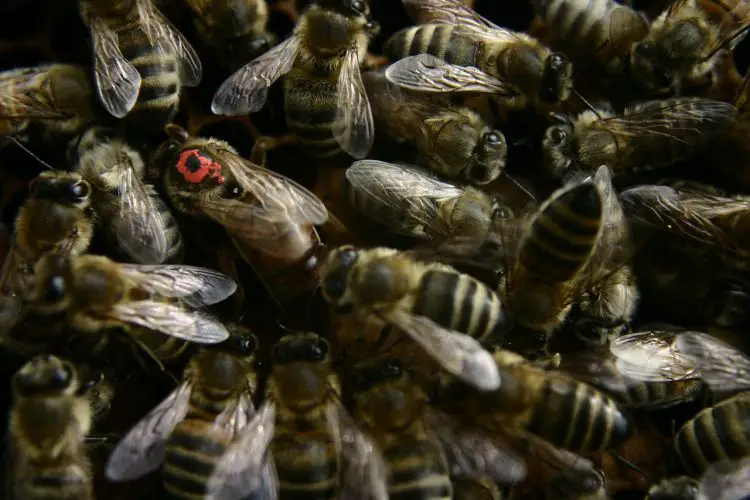Learning how to maintain a hive with a healthy queen is absolutely vital for all beekeepers. A queen will be able to produce fertilized eggs that will in turn grow into more worker bees, or even future queens. In addition, the presence of a queen will encourage the workers to be more productive, and work harder to produce brood and honey stores. While it is possible for a hive to survive for some time without a queen, it will hurt the productivity of the hive in the long run. Thus, it is absolutely crucial for a productive hive to maintain a healthy queen.
Why should I replace the queen bee?
There are several reasons that one might need to re-queen a hive, with some reasons being, such as the age of the queen,
Re-queening a hive can be an exceptionally daunting task for newcomers to the beekeeping world. However, once you fully understand the stepps required for re-queening a hive, it is actually a rather simple and straightforward process. The first step to re-queening a hive, is understanding if you need to re-queen in the first place. The re-queening process should usually occur every one to two years. There are several reasons that one might need to re-queen a hive. These reasons could include:
You have an old queen
A queen will typically live between three to five years. The queen will slowly begin to decrease in egg production as she grows older. For this reason, some beekeepers will re-queen the hive every two years to ensure that there is always a young and healthy queen in the hive producing eggs.
You have a queen who is laying fewer eggs
You may notice the hive showing a steady decrease in bee population, or that your queen is producing inconsistent numbers of eggs. An inconsistent production in eggs could harm the overall health of the hive, and should result in you replacing the queen as soon as possible.
Once you have determined that your hive needs to be re-queened, you should move forward with the process as soon as practical.
When Should You Re-Queen Your Hive?
Most beekeepers will re-queen their hives every September as an annual or semi-annual process. The reason why most beekeepers choose September is two-fold. Your queen will have more time to settle in to the hive, and the brood that she produces will have a longer lifespan due to their early months being spent within the hive. When spring arrives, your hive will be ready to explode with productivity. For these reasons, most beekeepers find that re-queening the hive is best done in September before the winter settles in.
Bear in mind, that you may incur some risk when re-queening in the colder months. This is partly due to the fact that workers will be more open to accepting a new queen in times when food is plenty. In a time of low nectar flow, your hive may not accept the new queen, and you could face issues in the short term. However, in most cases, the long term benefits outweigh the short term risks. This is why September is typically the optimal time.
The Process of Re-Queening Your Hive
The first step is to remove the old queen. If your old queen is not marked, you will be able to identify her by the ring of worker bees surrounding her. She will not be striped, and will have a slightly elongated abdomen. Once you have removed the old queen, you can begin the process of introducing the new queen. Some beekeepers will utilize essential oils or sugar syrup to mask the pheromones of the new queen, in hopes of increasing the chances of acceptance from the hive. Keep in mind that you should always wait at least 24 hours between removing the old queen, and introducing the new one.
Some new beekeepers will try to directly introduce the new queen into the hive immediately. This is almost always a bad idea, and can easily result in the hive perceiving the new queen as a threat. They will likely kill the new queen in this scenario. Instead, you should indirectly introduce the new queen; there are two ways that you can go about this.
Raise your own replacement queen
Raising your own queen is probably the most cost effective method. This will require you to purchase a clamp-like queen cage. It is a small device that you raise the queen in, where she can be exposed to the brood without risk of them killing her. By the time you introduce the new queen to the hive, the newly hatched brood will already be familiar with her.
Purchase a replacement queen
By contacting your local bee keeping association, you will be able to find a local queen for purchase. If you do not have access to a beekeeping association local to you, you may have to contact a beekeeping supplier. The newly purchased queen will come in a small container that is inserted into the hive. The container that she comes in will have a plug, cover, or cork that will need to be removed. Beneath this cover, there will be a small candy plug. This candy plug will keep the new queen separate from the hive workers. Over the course of two or three days, the workers will eat their way through the candy plug. By the time they have released the queen, she will already be accepted by the hive.
Determining which method of acquiring a new queen for your hive will largely depend on your own personal preferences. Just remember to take all the necessary precautions, and steps to allow the queen every opportunity to succeed. You never want to end up in a situation here your queen is rejected by the hive, and killed. This will result in a lot more hassle, and frustration on your end.
Conclusion
When it comes to re-queening the hive, a large portion of the process will be situational. You will have to determine the needs of the hive, and the best method for ensuring the future success of the hive. It is always best to consult other experienced beekeepers in your area if you are new to the re-queening process. They will have a better insight into the finer details of your hive’s personal situation with regards to the re-queening process.
Overall, the re-queening process is rather direct. However, it is understandable if you should feel a bit nervous or anxious at first. Just remember to take the time to follow the steps properly, and give your new queen every opportunity to succeed. In the end, your hive will be left with a new, and thriving queen for them to rally around, and take them into a more productive future.


![3 Big Mistakes Beginner Beekeepers Make [And How To Avoid Them!]](https://beekeepingabc.com/wp-content/uploads/2020/11/3-mistakes-beginner-beekeepers-make-90x75.jpg)

![Move over ducks, Queen Bees quack too! [Here’s Why]](https://beekeepingabc.com/wp-content/uploads/2020/06/queen-bee-90x75.png)
![The Flow Hive 2 Review [ Vs. The Classic Flow Hive]](https://beekeepingabc.com/wp-content/uploads/2020/02/Flow-Hive-2-90x75.jpg)
![How Bees Fly [10 Facts About How, When, and Why]](https://beekeepingabc.com/wp-content/uploads/2019/12/A-Bee-Flying-90x75.jpg)